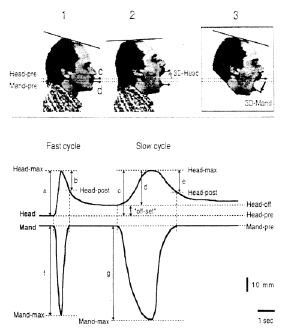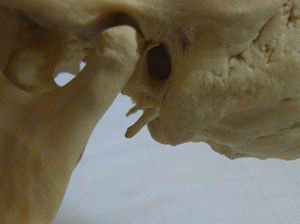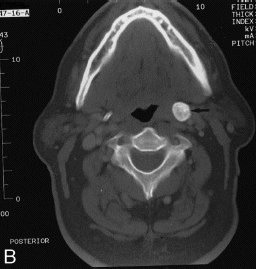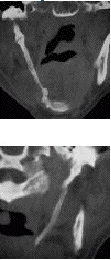- Integrated
jaw and neck function in
man
- Yawning
: first cause of temporomandibular
luxation
- Do you have
difficulty, pain or both when yawning
?
- A classic
symptom in temporomandibular disorder
!
-
- Jaw opening-closing, biting, chewing,
swallowing, yawning and speech require
unrestrained mandibular movements. Mandibular
functions (speech, laughing, yawning,
mastication,and taking a large bite) may be
impaired if temporomandibular disorders exist.
5% of an adult population had felt pain when
opening the mouth wide and 3% while
yawning or chewing! Yawning stay for the
fisrt cause of temporomandibulat luxation. See a
testimony below. Nelaton's
maneuver is the therapy.
-
- A functional linkage exists between the
human temporomandibular and craniocervical
regions. Head movements are an integral part of
natural jaw opening-closing. "Functional jaw
movements" comprise concomitant mandibular and
head-neck movements which involve the
temporomandibular, the atlanto-occipital and the
cervical spine joints, caused by jointly
activated jaw and neck muscles.
-
- Jaw and neck muscle actions are elicited and
synchronised by neural commands in common for
both the jaw and the neck motor systems. These
commands are preprogrammed, particularly at fast
speed. In the light of previous observations of
concurrent jaw and head movements during
foetal yawning, it is suggested that these
motor programs are innate. Neural processes
underlying integrated jaw and neck function are
invariant both in short- and long-term
perspectives. Integrated jaw and neck function
seems to be crucial for maintaining optimal
orientation of the gape in natural jaw function.
Injury to the head-neck, leading to whiplash
associated disorders may derange integrated
jaw-neck motor control and compromise natural
jaw function.
-
 -
- L'intégration
de la moticité
cervico-mandibulaire
- Le
bâillement : première cause de
luxation mandibulaire
- Avez-vous
des difficultés, une douleur ou les deux
quand vous bâillez ?
- Un
symptôme classique de désordres de
l'articulation temporo-mandibulaire
!
-
- Ouvrir et fermer la bouche, goûter,
mâcher, avaler, bâiller et parler
requièrent des mouvements plus ou moins
amples, sans gêne, de l'articulation
temporo-maxillaire. Toutes ces fonctions
(parler, rire, bâiller, mastiquer, prendre
une grosse bouchée) peuvent être
rendues difficiles par des désordres
fonctionnels de cette articulation. 5% de la
population adulte se plaint de douleurs lors de
la complète ouverture de la bouche, et
3% au cours du bâillement ou du
mâchonnement. Le bâillement est la
première cause de luxation de
l'articulation temporo-maxillaire. Voyez le
témoignage ci-dessous. Découvrir
la manoeuvre de réduction dite de
Nélaton.
-
- Il existe un lien fonctionnel entre
l'articulation temporo-maxillaire et la
région cervicale. Les mouvements de la
tête font partie intégrante du
cycle ouverture/fermeture de la bouche. On
définit "l'activité fonctionnelle
mandibulaire" comme une association de
mouvements concomitants de la nuque et de la
machoire dans lesquels interviennent les
articulations temporo-maxillaire,
atloïdo-axoïdienne et des autres
vertèbres cervicales, sous l'effet des
muscles masséters et du cou.
-
- L'action des muscles masséters et
cervicaux est synchronisée par une
commande motrice nerveuse commune. Cette
commande est quasi automatique surtout à
vitesse rapide. A la lumière des
observations
échographiques, montrant l'existence
de cette synchonie dès 12 semaines de
grossesse, on peut considérer cet
automatisme comme inné. Ces
mécanismes neuro-moteurs
intégrés sont très stables
et ne varient pas au cours de la vie depuis la
naissance jusqu'à un âge
avancé. Ils semblent cruciaux pour
maintenir une orientation optimale de
l'ouverture de la bouche au cours de cette
fonction naturelle. Les traumatismes du cou
comme le "coup du lapin" peuvent perturber cette
intégration motrice et compromettre la
fonction buccale.
-
- Why
yawning occurs frequently during the IV
induction of general
anesthesia?
-
- -Agbara
R, Fomete B, Obiadazie AC, Idehen K, Okeke
U. Temporomandibular joint dislocation:
experiences from Zaria, Nigeria. J Korean Assoc
Oral Maxillofac Surg. 2014;40(3):111-6.
- -Avidan
A Dislocation of the temporomandibular joint
due to forceful yawning during induction with
propofol J Clin Anesth; 2002;14:159
- -Dimitroulis
G Temporomandibular disorders: a clinical
update (pdf) BMJ1998;317:190-194
- -Forte MC
Le bâillement thèse de stomatologie
MC Forté, Bordeaux, 1982
- -Gorchynski
J, Karabidian E, Sanchez M. The ''syringe''
technique: a hands-free approach for the
reduction of acute nontraumatic
temporomandibular dislocations in the emergency
department. J Emerg Med. 2014;47(6):676-81
- -Harnier
S et al. Retropharyngeal tendinitis: a rare
differential diagnosis of severe headaches and
neck pain. Headache. 2008;48(1):158-161
- -Klécha
A, Hafian H, Devauchelle B, Lefèvre
B. A report of post-traumatic Eagle's
Syndrome. Int J Oral Maxillofac Surg.
2008;37(10):970-2
- Ku
J, Szarejko KD, Gobiewska M. Smiling,
Yawning, Jaw Functional Limitations and Oral
Behaviors With Respect to General Health Status
in Patients With Temporomandibular
Disorder&emdash;Myofascial Pain With Referral.
Front. Neurol. 2021 |
https://doi.org/10.3389/fneur.2021.646293
- -McCorkell
S Fractures of the styloid process and
stylohyoid ligament: an uncommon injury J of
Trauma 1985;25(10):1010-1012
- -McGinnis
J Fracture of an ossified stylohyoïd
bone Arch Otolaryngol 1981;107:460
- -Mercier
J La luxation de la machoire Rev Prat
Méd Générale1989;3(55) -
1997;11; 389
- -Ndiokwelu
E Bilateral dislocation of the mandible 2
cases in a nuclear family Odontostomatol Trop.
2005;28(112):27-3
- -Pae CU, JJ
Kim et al Injured temporomandibular joint
associated with fluoxetine-monotherapy-induced
repeated yawning Gen Hosp Psychiatry
2003;25(3):217-8
- -Tesfaye Y,
Lal S Hazard of yawning Canadian Med Assoc J
1990;142(1):15 et 1991;145(12):1560
- -Ugboko VI,
Oginni FO, Ajike SO, Olasoji HO, Adebayo ET.
A survey of temporomandibular joint dislocation:
aetiology, demographics, risk factors and
management in 96 Nigerian cases. Int J Oral
Maxillofac Surg. 2005;34(5):499-502
- -Unnikrishnan
KP, Sinha PK, Rao S. Mandibular dislocation
from yawning during induction of anesthesia. Can
J Anaesth. 2006;53(11):1164-5.
- -Yap AU, Tan KB, Hoe
JK, Yap RH, Jaffar J On-line computerized
diagnosis of pain-related disability and
psychological status of TMD patients: a pilot
study.J Oral Rehabil 2001;28(1):78-87
-
-
While
the patient was yawning vigorously, he heard a
loud crack !
- Fractures
of the styloid process and
yawning
-
- Fracture of an elongated styloid process or
ossified stylohyoid ligament is uncommon. Neck
or throat pain, decreased mobility, hoarseness,
and mass in the neck are signs and symptoms of
fracture. The inciting trauma may be as mild as
yawning
but more often blunt
trauma of a serious nature, such as motor
vehicle accident, is the cause. The diagnosis
may be missed because of difficulty imaging the
stylohyoid apparatus. Some cases are presented
that demonstrate the variability of symptoms and
trauma.
 - Pendant
que le patient bâillait amplement, il
entendit un craquement sourd
!
- Fractures
de l'apophyse styloïde et
bâillements
-
- Les fractures d'une longue apophyse
styloïde ou d'un ligament
stylo-hyoïdien ossifié ne sont pas
courantes. Des douleurs de la gorge ou du cou,
une mobilité réduite du cou, un
enrouement, une masse latérale du cou
sont autant de signes pouvant faire
évoquer cette pathologie. Le traumatisme
déclenchant peut être aussi
véniel qu'un
bâillement mais souvent correspond
à un
choc direct grave, comme au cours des
accidents de la circulation. Le diagnostic peut
être erroné ou retardé car
l'image radiologique est difficile à
réaliser. Quelques cas sont
présentés ici et démontrent
la variablité des signes et
symptômes de ce type de fractures.
-
- Eagle's
syndrome: a symptomatic calcification of the
stylohyoid ligaments
- A
case of symptomatic calcification of the
stylohyoid ligaments is described. The patient
presented with head and neck pain, with the neck
pain being reproduced by palpation of the
styloid process through the tonsillar fossa and
yawning. Calcification or ossification of the
stylohyoid ligament is a frequent, often
incidental finding on radiographs, however when
the source of pain is from the styloid process
or calcified stylohyoid ligaments it referred to
as Eagle's syndrome. The symptoms may be
confused with other causes of head and neck
pain. This paper also discusses the pain
patterns, clinical presentation, radiologic
findings and treatment of Eagle's syndrome.
-
-

-
- Syndrome
d'Eagle: calcifications symptomatiques des
ligaments
stylo-hyoïdiens
- Un
cas de calcification symptomatique des
ligaments stylo-hyoïdiens est
décrit. Le patient s'est
présenté avec des maux de
tête et une cervicalgie, la douleur au cou
étant reproduite par palpation du
processus styloïde dans la fosse
amygdalienne et le bâillement. La
calcification ou l'ossification du ligament
stylo-hyoïdien est fréquente et sa
découverte sur les radiographies est
fortuite. Lorsque la source de la douleur
provient du processus styloïde ou de
ligaments stylo-hyoïdiens calcifiés,
on la désigne sous le nom de «
syndrome d'Eagle ». Les
symptômes peuvent être confondus
avec d'autres causes de maux de tête et
cervicalgies. Cet article discute
également des schémas de la
douleur, de la présentation clinique, des
résultats radiologiques et du traitement
du syndrome d'Eagle.
-
- Eagle's
syndrome a
website
-
-
-
- History: A 10 year-old boy who has
throat pain while swallowing that began shortly
after tonsillectomy.
- Diagnosis: Eagle syndrome, also
called the stylo-hyoid ligament syndrome
-
- Discussion: The syndrome was
described by Dr. Watt W. Eagle in 1937
(Elongated styloid processes:
report of two cases. Arch Otolaryngol 1937; 25;
584-587). It consists of glossopharyngeal
nerve neuralgia caused by elongation of the
styloid process or calcification of the
stylo-hyoid ligament. Rarely, the whole ligament
is ossified to form a stylohyoid bone.Pain is
felt in the throat, head, teeth, and neck. The
pain may be caused by chewing, swallowing, head
turning, tongue protrusion, and yawning.
The pain may first occur after neck trauma or
tonsillectomy. The long styloid process or
calcified stylo-hyoid ligament are easily shown
on neck radiographs or by CT. Treatment is
surgical excision.
 -
- Fractures
of the styloid process and stylohyoid ligament:
an uncommon injury McCorkell J of Trauma
1985; 25; 10; 1010-1012
- Fracture
of an ossified stylohyoïd bone J
McGinnis Arch Otolaryngol 1981; 107;
460
- Calcified
stylohyoid ligament: unusual
pressure symptoms Fanibunda K
Dentomaxillofacial Radiology 1997; 26;
249-251
- Eagle's
syndrome: a
case of symptomatic calcification of
the stylohyoid ligaments pdf Feldman VB J
Can Chiropr Assoc 2003;47; 1:21-27
- CT
findings associated with
Eagle's syndrome pdf Murtagh R et al Am J
Neuroradiol 2001; 22; 1401-1402
- The
mineralized and elongated styloid process: a
review of current diagnostic criteria and
evaluation strategies. Mupparapu M, Robinson
MD. Gen Dent. 2005;53(1):54-59.
- A
report of post-traumatic Eagle's syndrome
Klecha A et al. Int J Oral Maxillofac Surg
2009
- A
patient with glossopharyngeal neuralgia: a
(un)known trap Tjakkes GH, Rijnvis DJ,
Timmenga NM, Stegenga B. Ned Tijdschr
Tandheelkd. 2008;115(5):263-5. (Dutch).
- Retropharyngeal
tendinitis: a rare differential diagnosis of
severe headaches and neck pain. Harnier S et
al. Headache. 2008;48(1):158-161
|








